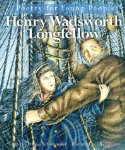Edited by Frances Schoonmaker
Illustrated by Chad Wallace
Poetry
For ages 9 and up
Sterling, 1998, 978-0-8069-9417-8
Henry Wadsworth Longfellow grew up in Portland, Maine.
Though his family was not wealthy, they were well off enough that Henry and his
siblings got a good education and they always had access to books. Henry grew
up to love the written word, and the things he saw around him inspired him to
write poetry. Often his poems described people and everyday events. In one of
his longer poems there is a scene where he describes a potter working at his
wheel. To him, the potter’s ability is like magic as “That shapeless, lifeless
mass of clay / Rise up to meet the master’s hand.” He also wrote about a
village blacksmith who, with “brawny arms” that are as “strong as iron bands,”
works all day long working the bellows and beating the metal with a “heavy
sledge.”
After going to
college and travelling to Europe to learn foreign languages, Henry became a
scholar and a teacher at Harvard. He also wrote poems when he could, including
long story poems such as Evangeline, Paul Revere’s Ride, and The Song of Hiawatha.
Then there were
the poems that were more personal. Moved by the plight of slaves, he wrote
eight poems that were combined in a little book called Poems on Slavery. Though his views made him unpopular with some
people, Henry always felt that slavery was a terrible practice and he tried to
show people what it would be like to be a slave. In The Slave’s Dream he tells the story of a slave who is thinking
about his homeland in Africa, and in The
Witness he gives a voice to all the slaves who drowned when the slave ship
they were on sank. On the ocean bed they lie and “cry, from yawning waves / “We
are the Witnesses.” They are the ones who know all about the cruelty of man
against man.
In this excellent
Poetry for Young People title, the editor’s introduction sets the scene for the
poetry selections that she chose to share with readers. Readers get a sense of
what kind of man Longfellow was, and how his life experiences influenced his
creative process. Knowing the poet’s story will help readers to better
appreciate his splendid poems.

No comments:
Post a Comment